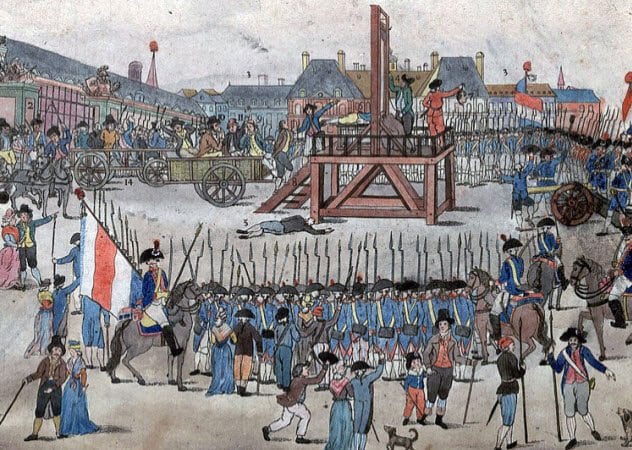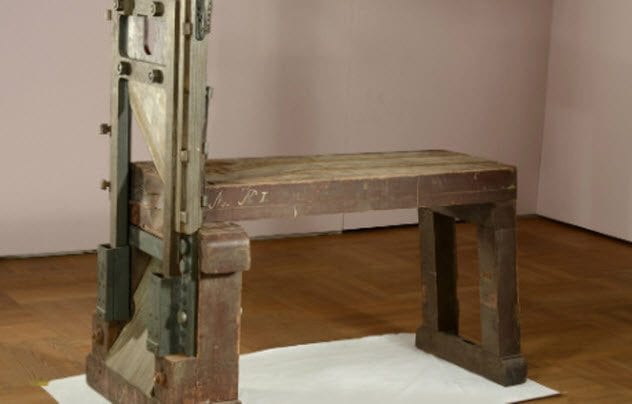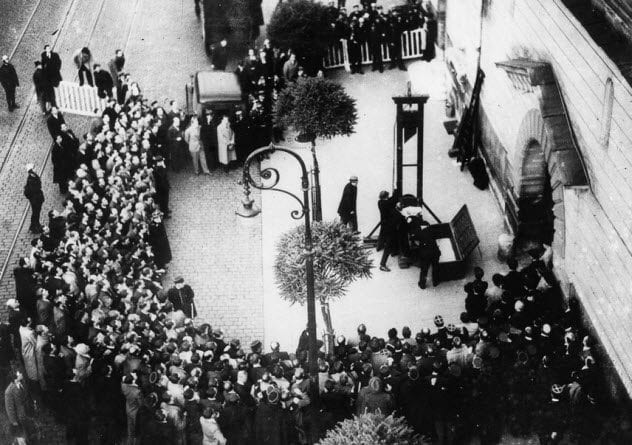 Mysteries
Mysteries  Mysteries
Mysteries  History
History 10 Surprising Stories About the Texas Rangers
 Humans
Humans 10 Philosophers Who Were Driven Mad by Their Own Theories
 Miscellaneous
Miscellaneous 10 Video-Game-Worthy Weapons and Armors from History
 Weird Stuff
Weird Stuff 10 Psychics Who Accurately Predicted Wartime Events
 The Arts
The Arts 10 Pieces of Art Inspired by a Broken Heart
 Health
Health 10 Science Fiction-Sounding New Medical Treatments
 History
History 10 Surprising Facts About the Father of Submarine Warfare
 Space
Space Ten Astonishing New Insights into Alien Worlds
 Weird Stuff
Weird Stuff 10 Bizarre Summer Solstice Rituals Still Practiced Today
 Mysteries
Mysteries Top 10 Haunting Facts About the Ghost Ship MV Alta
 History
History 10 Surprising Stories About the Texas Rangers
 Humans
Humans 10 Philosophers Who Were Driven Mad by Their Own Theories
Who's Behind Listverse?

Jamie Frater
Head Editor
Jamie founded Listverse due to an insatiable desire to share fascinating, obscure, and bizarre facts. He has been a guest speaker on numerous national radio and television stations and is a five time published author.
More About Us Miscellaneous
Miscellaneous 10 Video-Game-Worthy Weapons and Armors from History
 Weird Stuff
Weird Stuff 10 Psychics Who Accurately Predicted Wartime Events
 The Arts
The Arts 10 Pieces of Art Inspired by a Broken Heart
 Health
Health 10 Science Fiction-Sounding New Medical Treatments
 History
History 10 Surprising Facts About the Father of Submarine Warfare
 Space
Space Ten Astonishing New Insights into Alien Worlds
 Weird Stuff
Weird Stuff 10 Bizarre Summer Solstice Rituals Still Practiced Today
Top 10 Bizarre And Riveting Facts About The Guillotine
Contraptions that resulted in one’s beheading were used throughout Europe for centuries. However, the guillotine would forever overshadow previous death machines due to its use during the French Revolution. The following 10 entries detail peculiar facts pertaining to the guillotine, from its role during the Reign of Terror to its morbid present-day utilization.
10 Creation Of The Guillotine

Joseph Ignace Guillotin was said to have been born on the streets of Saintes, France, when his mother sporadically went into labor after hearing the horrifying screams of a man being executed on the town’s breaking wheel. Whether or not the story is true, French historian Daniel Arasse described how “the conditions of [Guillotin’s] birth determined his later renown.”
Guillotin, a physician who lobbied against the death penalty, devoted his career to making a device that would allow for a more humane method of execution. Guillotin’s advocacy in 1791 led the Assembly to declare that his contraption be the sole means of execution.
However, finding a carpenter to construct the device proved exceptionally difficult. Fearing the stigma associated with the machine, workmen refused the job. Then German harpsichord maker, Tobias Schmidt, agreed to do it if his name would not be connected to the device.
Despite popular myth, Guillotin was not decapitated by his own invention. Instead, he died at age 75 in 1814. Guillotin’s relatives were so embarrassed that their family name was synonymous with decapitation that they lobbied for the device’s name to be changed. Upon the French government’s refusal, the Guillotin family changed their own name. The guillotine was last used in France on a convicted murderer in 1977.
9 Lack Of Gore

Nicolas-Jacques Pelletier, who had been sentenced to death for robbery and murder, became the first person to be executed by the guillotine. On the morning of April 25, 1792, Pelletier was taken to a plaza outside of the Hotel de Ville, where an enthusiastic crowd awaited.
Moments after Pelletier set foot onto the platform, which was fittingly painted bloodred, the weighted blade was released, sending his head into the wicker basket below. Sawdust was shoveled onto the blood-soaked boards, ending the spectacle so many curious Parisians had gathered to see.
Unfortunately for the spectators, the execution was “too clinical and anticlimactic” and did not satisfy their thirst for gore. Disappointed at the lack of entertainment previously afforded to them, members of the audience began chanting, “Give me back my wooden gallows!”
Despite the protest, manufacturing of the guillotine hastily increased to supply towns throughout the country. This allowed executions to be carried out with great efficiency and speed. Case in point, executioner Charles-Henri Sanson is said to have executed 300 men and women in three days as well as 12 victims in just 13 minutes.
8 Experimentation

Contraptions similar to the guillotine began ages before the French Revolution. Nonetheless, the fine-tuning of the infamous mechanism occurred during the midst of such dreadful Parisian times.
To avoid public embarrassment on behalf of the government, the guillotine was tested on various subjects. The primary studies were live sheep and calves followed by human cadavers in 1792. Concluding that the tests were not up to par, three additional human corpses were selected based on their physical stature—well-built men who had not died in a fragile, weak state and preferably from an accident or sudden illness.
Initially intended to examine the accuracy of the guillotine, these experiments also guided medical scholars pertaining to disturbance-based experiments. Specifically, physicians were interested in discovering whether a particular organ served a vital function. Therefore, they used subtractive logic to find out.
By removing, damaging, or destroying an organ, such experiments determined whether that organ was essential to the particular function being studied. In this case, the removal of the head clearly spoke volumes for the brain’s role in the nervous system. Although that is clearly evident today, it was only a theory in the 18th century.
7 Vietnam

In 1955, a newly created government in South Vietnam, known as the Government of the Republic of Vietnam (GVN), came into existence. After a questionable election the following year, Ngo Dinh Diem was elected president.
Soon after, the anticommunist leader argued that North Vietnam (Democratic Republic of Vietnam) wanted to take over the South by force. Paranoid that the South had been infiltrated by conspirators insistent on overthrowing the GVN, Diem passed Law 10/59. It authorized that any and all people suspected of having communist ties be jailed without formal charges.
Those imprisoned faced horrendous torture, supported by an oppressive decree that ultimately carried the sentence of death. However, one did not have to be behind prison walls to fall victim to Diem’s murderous reign.
Insistent on instilling fear throughout the region, Diem had the military travel with a mobile guillotine. They went village to village seeking out anyone believed to have pledged loyalty to the Viet Cong.
Throughout the next few years, hundreds of thousands of South Vietnamese were beheaded. As if Diem was channeling the grotesque horrors of the Middle Ages, the heads of the accused—along with their intestines—were placed on stakes throughout the South.
6 A Profitable Nazi Venture

The guillotine experienced a renaissance during the Nazi era when Hitler personally ordered “a good number” of the machines to be built. The executioners became quite wealthy on their yearly salaries of 3,000 reichsmarks each, a considerable sum for the time.
In addition, executioners were paid a bonus of 65 reichmarks per decapitation, affording them a comfortable life in an era plagued with lunacy and terror. One of Nazi Germany’s most prominent executioners, Johann Reichhart, earned enough money from 3,000 beheadings to purchase a villa in a wealthy suburb in Munich.
The Nazis even saw a means to profit from the death machine by charging the families of those decapitated. Each family was billed 1.50 reichsmarks for every day their loved one was imprisoned and an additional 300 reichsmarks for the execution. Guillotines were used for nearly nine years, and 16,500 people were beheaded during that time. The youngest was Helmuth Hubener, condemned to die for distributing antiwar leaflets at age 17.
5 The Seconds That Follow Decapitation

After the guillotine blade falls, do the victim’s eyes see anything in the moments when the head travels from the scaffold to the wicker basket? Such theories have been tested on animals from rats to chickens. Yet the question remains: Is there consciousness?
Though logical minds are fully aware that the matter may never be answered, history begs the question. King Charles I, Anne Boleyn, and numerous condemned criminals such as Henri Languille are said to have undeniably expressed communication with their executioners after their beheadings.
Nevertheless, what can explain the haunting facial movements of the decapitated in the fleeting seconds after the event? “The wave of death,” as it’s been described, is a burst of activity from the brain tissue of the deceased. However, death is defined as the process of a loss of heart and brain activity.
According to a 2002 study published in the Journal of Cellular and Molecular Medicine, brain cells could very well show activity several weeks after the death of the individual. Such findings, however, do not correlate to a conscious brain, leaving one to ponder such a morbid yet fascinating medical hypothesis.
4 The Guillotine In North America

About 1,450 kilometers (900 mi) northeast of New York sits the island of St. Pierre, the site where the guillotine was first and last used for capital punishment in North America. It all began when Auguste Neel viciously murdered a fellow fisherman in a drunken rage in 1889. Interestingly enough, the guillotine had to be transported from the island of Guadeloupe to carry out Neel’s beheading.
Although the instrument of death was never used again as a means of execution in North America, legislators have since lobbied for it to be brought back. In fact, in the 1990s, Georgia State Representative Doug Teper argued that the use of the guillotine would make “organ donations by the executed easier.”
Though the proposal was rejected, Georgia has had a colorful past with capital punishment. There were more than 500 hangings from 1735 to 1924. Then the noose was replaced by the electric chair at Georgia State Prison. In 1938, corrections officials set a record for electrocuting six men in all of 81 minutes.
In recent years, Georgia lawmakers have tried to allow for the sentence of death without a unanimous jury verdict as well as lowering the age of eligibility to 16.
3 The Family Trade

Executioners were shunned by French society and were often refused service by local tradesmen. Bourreaux, as they were known, had to live outside city or town walls with their families given their despised profession.
Due to their tainted reputations, marriage with other families was remarkably difficult. Therefore, executioners and their family members were legally allowed to marry their own cousins.
Perhaps the most famous executioner in history was Charles-Henri Sanson who dipped his hand into the family profession at age 15. Sanson, who relished the fact that his method of death entailed “simplicity and absence of noise,” became a celebrity to the Parisians. His flamboyant vibrant fashion and elegant manner made him a fashionable icon even with members of the royal court.
Sanson’s most famous execution was King Louis XVI in 1793. Later that year, his son Henri carried on the family trade when he guillotined the king’s wife, Marie Antoinette. Sanson’s other son, Gabriel, was eager to fill his father’s shoes as well. However, following one beheading, Gabriel slipped on the bloody scaffold, falling to his death.
2 Eugene Weidmann

In 1937, Paris was on high alert in the wake of multiple murders of both men and women, including one young American socialite named Jean de Koven. Eugene Weidmann was ultimately tried and convicted for the heinous crime spree.
On June 17, 1939, Weidmann walked outside in front of the Prison Saint-Pierre, where a guillotine and rambunctious spectators awaited. From the start, the bloodthirsty crowd was unruly, which caused the execution to be delayed past the usual twilight hour.
The pandemonium only heightened after the decapitation as countless people rushed to dab up Weidmann’s blood with handkerchiefs as a souvenir. Newspapers denounced the actions of the audience, describing them as “disgusting, clamoring, [and] jostling.”
After pictures and film of the execution surfaced, authorities came to believe that public executions “promoted baser instincts of human nature and encouraged general rowdiness and bad behavior” as opposed to deterring would-be criminals. These outrageous actions immediately led French President Albert Lebrun to ban all future public executions. Thus, Eugene Weidmann was the last person in France to be publicly guillotined.
1 Suicide

Despite the guillotine falling out of popularity, such a barbaric practice has been used by those desperately seeking to end their pain. Case in point, in 2003, Boyd Taylor of England spent several weeks in his bedroom constructing a guillotine that was primed to switch itself on as he slept at 3:30 AM. The 36-year-old’s headless body was discovered by his father, who awoke to a noise that he believed was the sound of his chimney falling off the roof.
In 2007, a Michigan man was discovered several days after setting up his own mechanism in a wooded area behind a local business. Groundskeepers discovered his body after smelling odor from the man’s decaying remains.
Perhaps the most bizarre death was that of David Moore. In 2006, Moore constructed a guillotine from metal piping and a saw blade. However, the device did not initially work, leaving Moore gravely wounded.
He managed to walk to his bedroom, where his corpse was later discovered by New Hampshire police. In addition, police found that Moore had electrically wired 10 Molotov cocktails throughout the home. These devices, too, failed to function according to plan.
Adam is just a hubcap trying to hold on in the fast lane.








